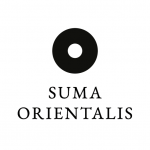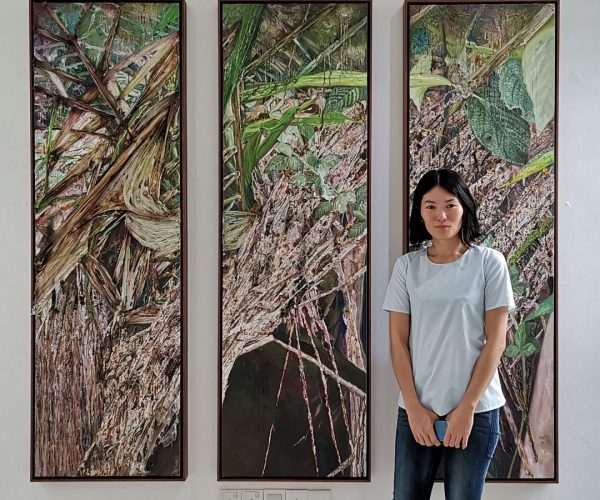
Tiong Chai Heing, the UOB Painting of the Year winner in 2015, is currently showing nine recent works at Suma Orientalis, her first major appearance following her feat. Titled ‘Im-permanence in the Antidote of Frailness’, Chai Heing is a Fine Arts graduate from Dasein Academy of Art, Kuala Lumpur. Chai Heing is equally proficient in oil painting and acrylic as well as in watercolour. Notably, she is also shortlisted in the recent Bakat Muda Sezaman (Young Contemporary Artists) Competition organised by the National Art Gallery which is currently now on exhibition.
Chai Heing’s upbringing circumambulate around the oil palm estate. Her adventurous spirit since young has attested to her bond with the treacherous wonders happening in and around the stretch of their own estate in Yong Peng, Johore. Thus, delving deep into the patterns of withering forms comes naturally to her. It epitomises her painting style. In this series, she also manipulated her canvasses with materials that includes fabric cut from used wedding gowns. Not only does it grant the works a craggy delineative texture, it also subtly alludes to the nimiety of man’s creation and the rejected found in society. This ele-mental exploration has led to an abysmal discerning on the material pursuits of umpteen feats, and the vulnerability of lives in front of nature’s altar. Mankind’s struggle is never more profound than any grit in the eons of time, whilst the only persisting subject is the qui-etus of all lives.Chai Heing’s works akin the visual rhythm of the shrivelling palm fronds and its surrounding overgrowth, to the final reconciliation with the hubbub of human lives, and finally redeeming the transcendence to atemporality.
In plain sentences, no matter how well a tree has grown or how successful we are, there will come a day when all our worldly concerns cease to matter anymore. That is when life ends.
Her body of works evolve around the idea of ‘impermanence’. In her own words, “It is diffi-cult for man to live without struggles and desires. That is the source of frustration in most people — so, only when man understands that impermanence is the final destination for each one of us, perhaps, the vulnerability and agony can be dissolved. That is the truth about our life. So, live with gratitude and hold no grudges. As we go on, one day when we look back, our pain and agony will matter no more.”
Through primary observation of the nature’s own ecology happening in the oil palm estate, she discovers that moths would lay eggs on old palm fronds and trunks. Eventually, the lar-vae would then feed off the ageing trees which is their natural habitat. When they are ma-tured and started to grow wings, they would all fly away, leaving the poor tree behind. It is a classic example of ecology, where the trees lost their lives while nurturing new lives.
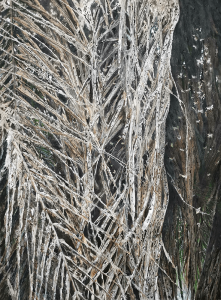
Using the raw images from an oil palm estate to portray something in contrary to the world-ly, materialistic subjects most people are “intoxicated” with all day long, the motives found in her works allegorically discerns on the meaning of impermanence derived through nature’s incidents. The artist also wants to bring to the viewer’s attention, the overproduc-tion and overconsumption in this world — one of the factors which swamped the oil palm industry with and creating umpteen controversy and conspiracy theories.
Chai Heing has also been caring for her autistic sister, who accompanies her in the studio most of the time. Because of this, Chai Heing is very aware of the needs and feelings of the marginalised group in society. Hence, the idea of “unwanted” things found their way into her paintings. The ageing trees are unwanted, and the image is enriched with unwanted materials as well.
Chai Heing uses oil paint as her primary medium. She also excels in watercolour. But what makes her works special, is how she manipulates objects like used fabric, beads and se-quins around on wedding gowns as she burn, bruise, colour and fix them onto her canvass-es to create those craggy texture. Her reason of using wedding gowns stems from its rare usage if it is not loan. She attempts to bring up the idea that most people are so used to disposables and have no time and heart to repair the despair.
It took her more than a year to complete the works for this exhibition.
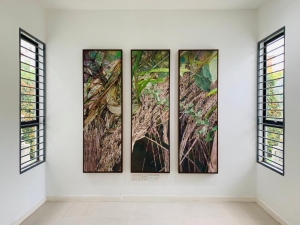
This is one of her favourite works in the show. In her words,’ It shows a great deal of ma-nipulated fabrics and how they react with the painted parts when affixed onto the canvas. This piece was conceptualised as a triptych so that when it is completed, some ‘breathing space’ can be kept between the panels, to lighten up the visuals otherwise it’ll be too heavy.” What seems to be an image from an oil palm estate, is so splendidly portrayed in the triptych.
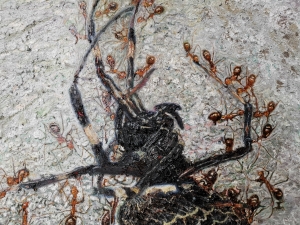
Another natural occurrence which fascinates Chai Heing is that the demise of a certain life appears to be a celebration for other species. In this work, the ants, despite them being tiny and feeble, somehow seems to have won the final victory over the spider.
Chai Heing spends her time observing the natural actions and reactions, and interpret these episodes with her artistic streak. The viewers of her works are often amazed by her realist painting skill. Chai Heing’s artistic execution is spot on when it comes to depicting and re-constructing the texture on canvas. She glazes and mutes certain colours where it is nec-essary to manipulate the viewer’s focus.
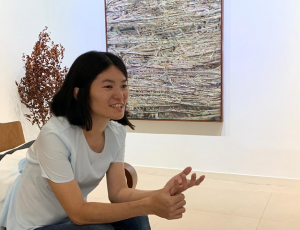
Roaming through the entire exhibition, the viewers would have a better understanding of Chai Heing’s thought process as she zooms in and out her subjects offering a macro and micro view at the same time. When she zooms in, the artist depicts the micro details of the palm fronds, which she conceptualises so well in pieces like this one is. The appearance of the molecular structure inevitably yet surprisingly lends it an abstract feel. It is a visual feast! And what seems to be monochromatic, was built by many layers of colour, including yellow, lilac, blue, olive green and so on, and with that, the final image comes alive! There is also a seamless connection between her realism paintings and her abstract works. This serves as an epic example of an excellent thinking piece of abstract work, closely related to the artist’s subject matter — in contrary to popular understanding and misunderstanding of abstract art especially those which shows random streaks and splashes of colours at the creator’s whims and fancies.
After Chai Heing puts down her brushes, she felt a burden lifting off her shoulder and at the same time, she feels compelled to express more. Afterall, to her, this is just the beginning of her journey in exploring impermanence as she craves for her viewers to enjoy the visuals and dive deep into her works, and at the same time, she wishes the viewers to also take some time to ponder over the extent of impermanence in their own lives, then lift up their head again leaving behind some emotional burden.
Such is the world of Tiong Chai Heing, a skilful, enigmatic artist of outstanding calibre who could easily adopt her lenses and her able hands into the micro as well as the macro as-pects that made up her universe, bridging mundane natural elements with simple philoso-phy that most will overlook.
Kris Lee
In Radar
